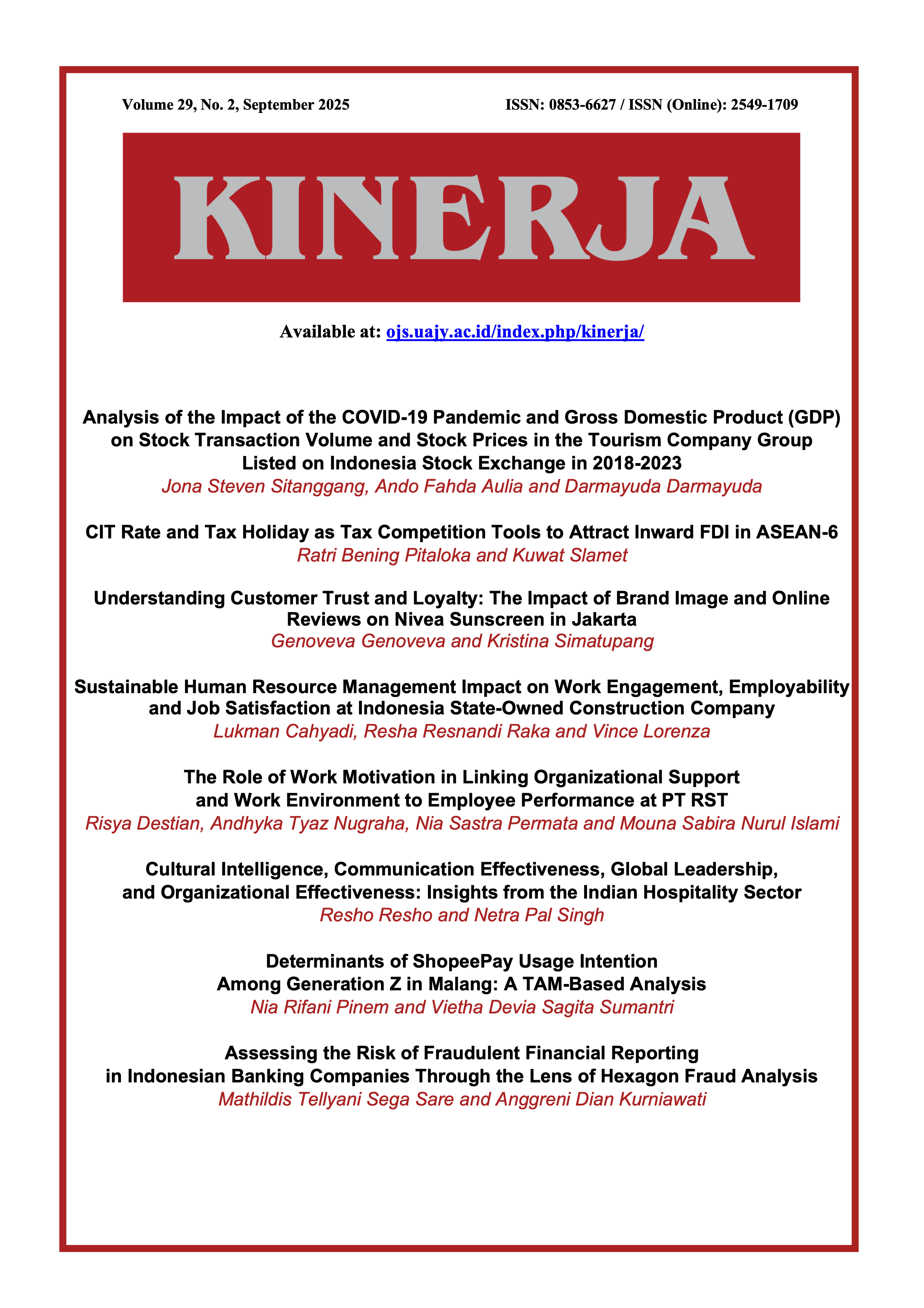Determinants of ShopeePay Usage Intention Among Generation Z in Malang: A TAM-Based Analysis
DOI:
https://doi.org/10.24002/kinerja.v29i2.9762Keywords:
e-wallet, ShopeePay, technology acceptance modelAbstract
E-wallets are a transaction tool that is most in demand by the people of Indonesia. One of the e-wallets that has a high number of enthusiasts in Indonesia is ShopeePay. This study aims to determine the factors influencing interest in using the ShopeePay e-wallet as a transaction tool for Generation Z in Malang. This study uses the TAM (Technology Acceptance Model) model with independent variables of perceived usefulness, perceived ease of use, perceived risk, perceived security, trust, and the dependent variable, namely interest in use. This research is quantitative. This research uses a purposive sampling method with data analysis using Partial Least Squares (PLS). The criteria in this study are members of Generation Z, born between 1997 and 2007, who use the ShopeePay e-wallet. The total number of respondents is 100 individuals. The results showed that perceived usefulness, perceived ease of use, and trust affect the interest in using the ShopeePay e-wallet. Meanwhile, perceived risk and perceived security do not affect interest in using the ShopeePay e-wallet.
References
Akbar, N.F., 2019. Analisis Persepsi Manfaat, Persepsi Kemudahan, dan Kualitas Pelayanan terhadap Kepuasan Pengguna Aplikasi Komunikasi Snaapp pada SD Ignatius Slamet Riyadi Karawang. Indikator, 3(3), p.353468.
Alfatih, A.A., Efendi, B., Nurhayati, E.C. and Purwanto, H., 2023. Analisis faktor-faktor yang mempengaruhi minat penggunaan e-wallet pada generasi milenial di kabupaten Wonosobo:(Studi kasus pengguna e-wallet ShopeePay). Jurnal Akuntansi, Manajemen dan Perbankan Syariah, 3(3), pp.50-62.
Bastian, D., Pratama, G.P.O., and Saputra, R.F., 2021. Analyze factors that affecting people using e-wallet service with government support and perceived security: TRA approach. Turkish Online Journal of Qualitative Inquiry (TOJQI), 12(6), pp.349–36.1
BI Institute, 2023. Kejahatan Keuangan dalam Pembayaran Digital. Available at: https://www.bi.go.id/id/bi-institute/BI-Epsilon/Pages/Kejahatan-Keuangan-Dalam-Pembayaran-Digital [Accessed: 9 August 2025].
Brahmanta, G.P. and Wardhani, N.I.K., 2021. Pengaruh persepsi kebermanfaatan, kemudahan, risiko terhadap minat menggunakan ulang shopeepay di Surabaya. Sains Manajemen: Jurnal Manajemen Unsera, 7(2), pp.97-108. Available at: https://doi.org/10.30656/sm.v7i2.3580.
Davis, F.D., 1989. Perceived usefulness, perceived ease of use, and user acceptance of information technology. MIS Quarterly: Management Information Systems, 13(3), pp.319–339. Available at: https://doi.org/10.2307/249008.
Desky, H., Murinda, R. and Razali, R., 2022. Pengaruh persepsi keamanan, kualitas informasi dan kepercayaan terhadap keputusan pembelian online. Owner, 6(2), pp.1812–1829. Available at: https://doi.org/10.33395/owner.v6i2.772.
Diva, M. & Anshori, M.I., 2024. Penggunaan e-wallet sebagai inovasi transaksi digital: Literatur review. MULTIPLE: Journal of Global and Multidisciplinary, 2(6), pp.1991–2002.
Ernawati, N. & Noersanti, L., 2020. Pengaruh persepsi manfaat, kemudahan penggunaan dan kepercayaan terhadap minat penggunaan pada aplikasi OVO. Jurnal Manajemen STEI, 3(2), pp.2442–4080.
Hikmah, A., 2023. Pengaruh persepsi manfaat dan persepsi keamanan terhadap niat menggunakan melalui kepercayaan konsumen pada aplikasi dompet digital DANA. Journal of Management and Creative Business (JMCBUS), 1(3), pp.181–202. Available at: https://doi.org/https://doi.org/10.30640/jmcbus.v1i4.1433.
Iffat, M.F. & Laksmi, A.C., 2023. Pengaruh persepsi manfaat, persepsi kemudahan penggunaan, persepsi risiko terhadap minat masyarakat menggunakan dompet elektronik di Kota Medan. Proceeding of National Conference on Accounting & Finance, 5, pp.441–449. Available at: https://doi.org/10.20885/ncaf.vol5.art50.
Indriyani, D. & Sartika, S.H., 2022. Persepsi generasi Z pada penggunaan e-wallet selama pandemi COVID-19. Jurnal Sekretari dan Manajemen, 6(1), pp.68–74.
Jannah, S., 2022. Faktor-faktor yang memengaruhi minat pengguna e-wallet dalam transaksi keuangan (studi kasus pengguna e-wallet pada mahasiswa UIN KHAS Jember). Jurnal Ekonomi Syariah, 1, p.2022.
Jogiyanto, H., 2019. Sistem Informasi Keperilakuan. Yogyakarta: Andi Offset.
Karim, M.W. et al., 2020. Factors influencing the use of e-wallet as a payment method among Malaysian young adults. Journal of International Business and Management. Available at: https://doi.org/10.37227/jibm-2020-2-21/.
Kuswanto, T.Y.L. & Baridwan, Z., 2016. Pengaruh kepercayaan, persepsi manfaat, persepsi kemudahan dan persepsi keamanan terhadap minat penggunaan transaksi online. Jurnal Ilmiah Mahasiswa Fakultas Ekonomi dan Bisnis Universitas Brawijaya, 4(2), pp.1–29.
Laksmidewi, D. & Kumara, K., 2024. Effect of perceived risk on intention to use of e-wallet in Jabodetabek with the mediation of perceived usefulness and perceived ease of use. Journal of Business Studies and Mangement Review, 8(1), pp.63–70. Available at: https://doi.org/10.22437/jbsmr.v8i1.38259.
Lusiana, A. & Ichsanuddin, D., 2022. Analisis keputusan penggunaan ShopeePay mahasiswa manajemen Universitas Pembangunan Nasional Veteran Jawa Timur. Jurnal Sosial Ekonomi dan Humaniora, 8(3), pp.391–397. Available at: https://doi.org/10.29303/jseh.v8i3.93.
Maulana, R. & Zoraya, I., 2024. Pengaruh perceived ease of use, kepercayaan dan literasi keuangan terhadap penggunaan ShopeePay pada masyarakat Bengkulu. Jesya, 7(1), pp.640–654. Available at: https://doi.org/10.36778/jesya.v7i1.1442
Muzaki, A.I., Ahmad, G.N., & Noviarini D., 2025. Pengaruh perceived risk, ease of use, dan comfortability terhadap minat penggunaan sistem pembayaran digital e-money (Studi kasus Transjakarta). Jejak Digital: Jurnal Ilmiah Multidisiplin, 1(5), pp.2875-2891. Available at: https://doi.org/10.63822/m54dy208
Prakosa, A. & Sumantika, A., 2020. Analisis technology acceptance model pada pengguna dompet digital di Daerah Istimewa Yogyakarta. Jurnal Manajemen, 10(2), pp.137–146.
Prestama, F.B., Iqbal, M. & Riyadi, S., 2019. Potensi finansial teknologi syariah dalam menjangkau pembiayaan non-bank. Al-Masraf: Jurnal Lembaga Keuangan dan Perbankan, 4(2), p.147. Available at: https://doi.org/10.15548/al-masraf.v4i2.264
Priyono, A., 2017. Analisis pengaruh trust dan risk dalam penerimaan teknologi dompet elektronik Go-Pay. Jurnal Siasat Bisnis, 20(1), pp.88–106. Available at: https://doi.org/10.20885/jsb.vol21.iss1.art6
Rahardjo, B., 2015. Keamanan Sistem Informasi Berbasis Internet. Bandung: PT Insan Infonesia.
Rahmadhani, S. D., Buchdadi, A. D., Fawaiq, M., & Prasetya, B. A., 2023. Determinants of intention to use e-wallet in Generation Z. BISMA (Bisnis Dan Manajemen), 15(1), pp.60–77. Available at: https://doi.org/10.26740/bisma.v15n1.p60-77
Rodiah, S.R. & Melati, I.S., 2020. Pengaruh kemudahan penggunaan, kemanfaatan, risiko, dan kepercayaan terhadap minat menggunakan e-wallet pada generasi milenial Kota Semarang. Journal of Economic Education and Entrepreneurship, 1(2), p.66. Available at: https://doi.org/10.31331/jeee.v1i2.1293
Santosa, P.I., 2018. Metode penelitian kuantitatif – pengembangan hipotesis dan pengujiannya menggunakan SmartPLS. Yogyakarta: CV Andi Offset.
Sari, L.R., Anggraini, R., Kencanawati, M.S. and Sularto, L., 2022. Dampak Keamanan, Manfaat, Kepercayaan, Promosi, serta Kemudahan pada Keputusan Pemanfaatan Dompet Elektronik Shopeepay. Metik Jurnal, 6(1), pp. 59–69. Available at: https://doi.org/10.47002/metik.v6i1.335
Sugara, A. & Dewantara, R.Y., 2017. Analisis kepercayaan dan kepuasan terhadap penggunaan sistem transaksi jual beli online (studi pada konsumen “Z”). Jurnal Administrasi Bisnis (JAB), 52(1), pp.8–15.
Umaningsih, W.P. & Wardani, D.K., 2020. Pengaruh persepsi kemudahan, fitur layanan, dan keamanan terhadap niat menggunakan e-money. Jurnal Akuntansi dan Ekonomi, 5(3), pp.113–119. Available at: https://doi.org/10.29407/jae.v5i3.14057
Utomo, Y., S.I. & L., 2016. Penerapan technology acceptance model (TAM) untuk mengukur perilaku konsumen dalam penggunaan digitalisasi Yellow Pages (studi kasus pada perusahaan MD Media Surabaya). Seminar Nasional dan Konferensi Nasional IDEC 2016, pp.194–203.
Venkatesh, V. & Davis, F.D., 2000. Theoretical extension of the technology acceptance model: Four longitudinal field studies. Management Science, 46(2), pp.186–204. Available at: https://doi.org/10.1287/mnsc.46.2.186.11926
Welly, Y. et al., 2020. Factors of using non-cash payments to the consumption level of students in Pematangsiantar City. Jurnal Bisnis dan Manajemen, 7(1), pp.61–68. Available at: https://doi.org/10.26905/jbm.v7i1.4041
Yogananda, A.S. & Dirgantara, I.M.B., 2017. Pengaruh persepsi manfaat, persepsi kemudahan penggunaan, kepercayaan dan persepsi risiko terhadap minat untuk menggunakan instrumen uang elektronik. Diponegoro Journal of Management, 6(4), pp.1–7.
Zulaiha, M. T., Lamijan, L. & Sejati, H., 2024. Legal strategy to prevent and overcome abuse of funds in digital wallets. Journal of Social Science (JoSS), 3(7), pp. 1538–1546. Available at: https://doi.org/10.57185/joss.v3i7.338
Downloads
Published
Issue
Section
License
Copyright (c) 2025 Nia Rifani Pinem, Vietha Devia Sagita Sumantri

This work is licensed under a Creative Commons Attribution 4.0 International License.















